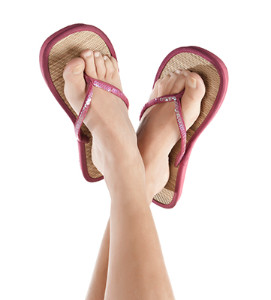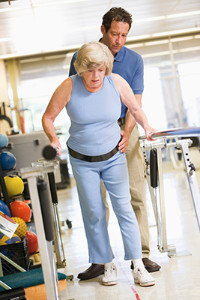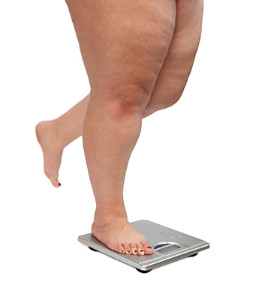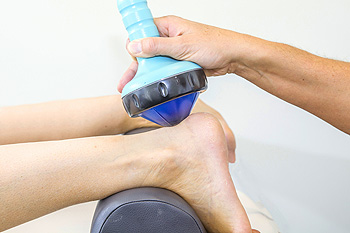 Recent research has shown that wearing specific types of flip flops may be beneficial in relieving some of the the discomfort that is associated with plantar fasciitis. There are several types of flip flops that may offer proper arch support, are easily worn, and are convenient to wear. When choosing to purchase this type of shoe, the importance of looking for specific features may be crucial in maintaining comfort and stability that is needed for daily activities. These may include insuring that there is a deep area the heel can fit comfortably in, in addition to having the arch supported properly. If you are afflicted with plantar fasciitis, it’s suggested to speak with a podiatrist who can properly evaluate this ailment and advise you on correct treatment options.
Recent research has shown that wearing specific types of flip flops may be beneficial in relieving some of the the discomfort that is associated with plantar fasciitis. There are several types of flip flops that may offer proper arch support, are easily worn, and are convenient to wear. When choosing to purchase this type of shoe, the importance of looking for specific features may be crucial in maintaining comfort and stability that is needed for daily activities. These may include insuring that there is a deep area the heel can fit comfortably in, in addition to having the arch supported properly. If you are afflicted with plantar fasciitis, it’s suggested to speak with a podiatrist who can properly evaluate this ailment and advise you on correct treatment options.
Flip-flops are not always the best choice of footwear. If you have any concerns about your feet or ankles, contact Dr. Morris Stribling from Foot Care of Central San Antonio. Our doctor will assist you with all of your foot and ankle needs.
Flip-Flops and Feet
When the weather starts warming up, people enjoy wearing flip-flops. Flip-flops are comfortable, stylish, and easy to slip on and off; they're perfect for any summer beach goer. However, these shoes can cause harm to the feet.
How Can Flip-Flops Affect Me Long-Term?
Are there injuries associated with flip-flops?
Yes. Since flip-flops are relatively weak and do not provide the same amount of support as sneakers, people who wear flip-flops regularly are more susceptible to injuries. On top of that, the open nature of the shoe makes your feet more prone to other problems, such as cuts and even infections. Common injuries and ailments include:
I like wearing flip-flops, are there safe alternatives?
When buying flip-flops, try to find ones that have sturdy soles and that are made of high quality materials that will support for your feet. These flip-flops will cost more, but will also last longer as a result.
If you have any questions please feel free to contact our office located in Central San Antonio, TX. We offer the newest diagnostic and treatment technologies for all your foot and ankle needs.
Read more about Flip Flops and Feet Varicose veins are a common problem for women across the world. The biggest risk factor for developing this condition is heredity. Surprisingly, over 80% of people who have varicose veins have them because of genetics. If you are looking for ways to reduce your risk of getting varicose veins, you should start by making lifestyle modifications. Maintaining an optimal weight, avoiding a sedentary lifestyle, and avoiding wearing tight clothes and heels are all ways you can reduce your risk of developing the disease. Although people consider this condition to be a cosmetic problem, it can also cause you to feel symptoms such as heaviness, pain, itching, swelling, burning, numbness, and cramps. If you have varicose veins in your lower extremities, such as the foot, you should consult with your podiatrist.
Varicose veins are a common problem for women across the world. The biggest risk factor for developing this condition is heredity. Surprisingly, over 80% of people who have varicose veins have them because of genetics. If you are looking for ways to reduce your risk of getting varicose veins, you should start by making lifestyle modifications. Maintaining an optimal weight, avoiding a sedentary lifestyle, and avoiding wearing tight clothes and heels are all ways you can reduce your risk of developing the disease. Although people consider this condition to be a cosmetic problem, it can also cause you to feel symptoms such as heaviness, pain, itching, swelling, burning, numbness, and cramps. If you have varicose veins in your lower extremities, such as the foot, you should consult with your podiatrist.
Vascular testing plays an important part in diagnosing disease like peripheral artery disease. If you have symptoms of peripheral artery disease, or diabetes, consult with Dr. Morris Stribling from Foot Care of Central San Antonio. Our doctor will assess your condition and provide you with quality foot and ankle treatment.
What is Vascular Testing?
Vascular testing checks for how well blood circulation is in the veins and arteries. This is most often done to determine and treat a patient for peripheral artery disease (PAD), stroke, and aneurysms. Podiatrists utilize vascular testing when a patient has symptoms of PAD or if they believe they might. If a patient has diabetes, a podiatrist may determine a vascular test to be prudent to check for poor blood circulation.
How is it Conducted?
Most forms of vascular testing are non-invasive. Podiatrists will first conduct a visual inspection for any wounds, discoloration, and any abnormal signs prior to a vascular test.
The most common tests include:
These tests are safe, painless, and easy to do. Once finished, the podiatrist can then provide a diagnosis and the best course for treatment.
If you have any questions, please feel free to contact our office located in Central San Antonio, TX. We offer the newest diagnostic and treatment technologies for all your foot care needs.
Read more about Vascular Testing in Podiatry
 If you enjoy the sport of running or jogging, you may develop a stress fracture. This may gradually occur from the frequent repetitive motion that accompanies this type of activity. Despite the fact that many people who engage in sports may endure the discomfort of a stress fracture, certain individuals may be prone to developing this ailment. This may include having a medical condition that may weaken the bones, or experiencing a disorder that may affect the nerves. This may result in a loss of feeling. The pain that is associated with this condition may not be felt. The noticeable symptoms may include pain and discomfort and may be more intense in one foot. After an MRI or bone scan is performed, the proper treatment options can be discussed, such as possibly wearing a cast or boot or taking certain medications. Please consult with a podiatrist if you have endured a stress fracture and would like information about correct treatment techniques that are right for you.
If you enjoy the sport of running or jogging, you may develop a stress fracture. This may gradually occur from the frequent repetitive motion that accompanies this type of activity. Despite the fact that many people who engage in sports may endure the discomfort of a stress fracture, certain individuals may be prone to developing this ailment. This may include having a medical condition that may weaken the bones, or experiencing a disorder that may affect the nerves. This may result in a loss of feeling. The pain that is associated with this condition may not be felt. The noticeable symptoms may include pain and discomfort and may be more intense in one foot. After an MRI or bone scan is performed, the proper treatment options can be discussed, such as possibly wearing a cast or boot or taking certain medications. Please consult with a podiatrist if you have endured a stress fracture and would like information about correct treatment techniques that are right for you.
Activities where too much pressure is put on the feet can cause stress fractures. To learn more, contact Dr. Morris Stribling from Foot Care of Central San Antonio. Our doctor can provide the care you need to keep your pain free and on your feet.
Dealing with Stress Fractures of the Foot and Ankle
Stress fractures occur in the foot and ankle when muscles in these areas weaken from too much or too little use. The feet and ankles then lose support when walking or running from the impact of the ground. Since there is no protection, the bones receive the full impact of each step. Stress on the feet can cause cracks to form in the bones, thus creating stress fractures.
What are Stress Fractures?
Stress fractures occur frequently in individuals whose daily activities cause great impact on the feet and ankles. Stress factors are most common among:
Symptoms
Pain from the fractures occur in the area of the fractures and can be constant or intermittent. It will often cause sharp or dull pain with swelling and tenderness. Engaging in any kind of activity which involves high impact will aggravate pain.
If you have any questions please feel free to contact our office located in Central San Antonio, TX. We offer the newest diagnostic and treatment technologies for all your foot and ankle needs.
Read more about Dealing with Stress Fractures of the Foot and Ankle Many people have found that making simple adjustments in the household may aid in preventing falls from occurring. These changes may include installing grab bars in the shower area, keeping the lighting bright in the house, repairing loose carpet, in addition to removing the majority of the clutter that may be present. Research has shown falling to be the number one cause of injuries in elderly people, and this may result in serious injuries. It can be a frightening experience, and many seniors may not engage in certain activities to prevent a fall from occurring. Additionally, it may be beneficial to live on one floor, which will eliminate the possibility of falling down any steps. When non-slip mats are used in the bath and shower areas, the risk of falling may be decreased. It’s important to pay close attention to any condition in the house, which may promote falling.
Many people have found that making simple adjustments in the household may aid in preventing falls from occurring. These changes may include installing grab bars in the shower area, keeping the lighting bright in the house, repairing loose carpet, in addition to removing the majority of the clutter that may be present. Research has shown falling to be the number one cause of injuries in elderly people, and this may result in serious injuries. It can be a frightening experience, and many seniors may not engage in certain activities to prevent a fall from occurring. Additionally, it may be beneficial to live on one floor, which will eliminate the possibility of falling down any steps. When non-slip mats are used in the bath and shower areas, the risk of falling may be decreased. It’s important to pay close attention to any condition in the house, which may promote falling.
Preventing falls among the elderly is very important. If you are older and have fallen or fear that you are prone to falling, consult with Dr. Morris Stribling from Foot Care of Central San Antonio. Our doctor will assess your condition and provide you with quality advice and care.
Every 11 seconds, an elderly American is being treated in an emergency room for a fall related injury. Falls are the leading cause of head and hip injuries for those 65 and older. Due to decreases in strength, balance, senses, and lack of awareness, elderly persons are very susceptible to falling. Thankfully, there are a number of things older persons can do to prevent falls.
How to Prevent Falls
Some effective methods that older persons can do to prevent falls include:
Falling can be a traumatic and embarrassing experience for elderly persons; this can make them less willing to leave the house, and less willing to talk to someone about their fears of falling. Doing such things, however, will increase the likelihood of tripping or losing one’s balance. Knowing the causes of falling and how to prevent them is the best way to mitigate the risk of serious injury.
If you have any questions, please feel free to contact our office located in Central San Antonio, TX. We offer the newest diagnostic and treatment technologies for all your foot care needs.
Read more about Falls Prevention Recent research has shown that approximately 70 percent of the population in the Bahamas are obese. This typically impacts the general health of the feet as a result of the additional weight the feet must endure. An increased BMI, or body mass index, generally accompanies any weight that is gained. This may produce unwanted foot conditions that may include plantar fasciitis, tendonitis, arthritis and general “wear and tear” of the bones, ligaments, and tendons. Additionally, the structure of the foot may be negatively affected, which may aid in difficulty maintaining an exercise program. While purchasing shoes, it’s important to choose shoes that fit correctly, which may help to diminish a portion of the pain that may be experienced. If you feel you are obese and would like additional information about this condition on how it may affect the feet, please consult with a podiatrist.
Recent research has shown that approximately 70 percent of the population in the Bahamas are obese. This typically impacts the general health of the feet as a result of the additional weight the feet must endure. An increased BMI, or body mass index, generally accompanies any weight that is gained. This may produce unwanted foot conditions that may include plantar fasciitis, tendonitis, arthritis and general “wear and tear” of the bones, ligaments, and tendons. Additionally, the structure of the foot may be negatively affected, which may aid in difficulty maintaining an exercise program. While purchasing shoes, it’s important to choose shoes that fit correctly, which may help to diminish a portion of the pain that may be experienced. If you feel you are obese and would like additional information about this condition on how it may affect the feet, please consult with a podiatrist.
Obesity has become very problematic at this point in time and can have extremely negative effects on the feet. If you’re an obese individual and are concerned about your feet, contact Dr. Morris Stribling from Foot Care of Central San Antonio. Our doctor can provide the care you need to keep you pain-free and on your feet.
Obesity and your Feet
Since your feet are what support your entire weight when standing, any additional weight can result in pain and swelling. Being overweight is one of the main contributors to foot complications.
Problems & Complications
Extra Weight – Even putting on just a few extra pounds could create serious complications for your feet. As your weight increases, your balance and body will shift, creating new stresses on your feet. This uneven weight distribution can cause pain, even while doing the simplest tasks, such as walking.
Diabetes – People who are overweight are at serious risk of developing type-2 diabetes, which has a drastic impact on the health of your feet. As you get older, your diabetes might worsen, which could lead to loss of feeling in your feet, sores, and bruises. You could also become more prone to various infections.
Plantar fasciitis – Pressure and stress that is placed on muscles, joints, and tendons can trigger plantar fasciitis, which is an inflammation of tissue that forms along the bottom of the foot.
If you have any questions please feel free to contact our office located in Central San Antonio, TX. We offer the newest diagnostic and treatment technologies for all your foot and ankle needs.
Read more about How Obesity Affects Your Feet There is a technique that is referred to as extracorporeal shock wave therapy, which is also known as ESWT, that may aid in treating certain foot conditions such as plantar fasciitis. There are two types of shock wave treatments that may be used, and these are referred to as low-energy and high-energy treatments. Low-energy treatments are typically administered over a period of time and may produce mild discomfort. The opposite may be true of the latter, and is often performed in a single treatment, which may often require general anesthesia. The purpose of these treatments is to promote healing of the tissues and surrounding areas affected by the foot condition. Recent research has shown little effectiveness of these treatments and many patients may still have pain after treatment. It’s important to speak with a podiatrist if you would like additional information about shockwave therapy.
There is a technique that is referred to as extracorporeal shock wave therapy, which is also known as ESWT, that may aid in treating certain foot conditions such as plantar fasciitis. There are two types of shock wave treatments that may be used, and these are referred to as low-energy and high-energy treatments. Low-energy treatments are typically administered over a period of time and may produce mild discomfort. The opposite may be true of the latter, and is often performed in a single treatment, which may often require general anesthesia. The purpose of these treatments is to promote healing of the tissues and surrounding areas affected by the foot condition. Recent research has shown little effectiveness of these treatments and many patients may still have pain after treatment. It’s important to speak with a podiatrist if you would like additional information about shockwave therapy.
Shockwave therapy is a treatment commonly used to treat various injuries and conditions, particularly plantar fasciitis in the feet. To learn more, consult with Dr. Morris Stribling from Foot Care of Central San Antonio. Our doctor can provide the care you need to keep you pain-free and on your feet.
Shockwave Therapy
Shockwave therapy is a new treatment option designed to treat bone conditions such as tennis elbow, shoulder pain, and others. Shockwave therapy uses high intensity sound waves that are directed to the affected tissues of the body with pinpoint accuracy. The effects are very beneficial, leading to a production of collagen fibers, eliminating inflammation.
Who Benefits from Shockwave?
Shockwave is recommended for patients suffering from heel pain and associated problems. Heel pain is a common condition which can be caused by obesity, overexertion, and spending a substantial amount of time on hard floors with your feet exposed and unsupported.
Fast and Easy
The therapy is actually a simple process that can leave patients feeling better the very next day. Shockwave therapy is not as dramatic as it sounds. It enables more blood flow to effected areas, addressing the source of the problem and allowing treatment to last for a long time.
Treatment & Recovery Time
Shockwave treatment will enable your feet to recover quickly. This is especially important since surgery is not required. It is cost effective and does not require the use of anesthesia. This treatment is a better option to surgery, since it is proven safe.
If you have any questions, please feel free to contact our office located in Central San Antonio, TX. We offer the newest diagnostic and treatment technologies for all your foot and ankle needs.
Read more about Treating Heel Pain with Shockwave Therapy It’s beneficial for children to learn at an early age how to properly take care of their feet. One way to accomplish this includes teaching them how to wash and dry their feet daily, especially in between the toes. Additionally, learning how to properly trim the toenails is a crucial element, which may prevent unpleasant foot conditions from developing, such as ingrown toenails. If your child should complain about heel pain, predominantly in the morning, a plantar’s wart may have developed. This may be avoided by teaching your child to wear appropriate shoes in the shower and pool areas, which may prevent the fungus that causes this condition to occur, to stop from entering the feet. If you notice your child scratching their feet, an ailment that is referred to as athlete's foot may have developed. Research has shown this may be avoided by wearing clean shoes and socks and showering or bathing in a clean area. It’s advised to have your child visit a podiatrist to learn about proper techniques for caring for the feet.
It’s beneficial for children to learn at an early age how to properly take care of their feet. One way to accomplish this includes teaching them how to wash and dry their feet daily, especially in between the toes. Additionally, learning how to properly trim the toenails is a crucial element, which may prevent unpleasant foot conditions from developing, such as ingrown toenails. If your child should complain about heel pain, predominantly in the morning, a plantar’s wart may have developed. This may be avoided by teaching your child to wear appropriate shoes in the shower and pool areas, which may prevent the fungus that causes this condition to occur, to stop from entering the feet. If you notice your child scratching their feet, an ailment that is referred to as athlete's foot may have developed. Research has shown this may be avoided by wearing clean shoes and socks and showering or bathing in a clean area. It’s advised to have your child visit a podiatrist to learn about proper techniques for caring for the feet.
The health of a child’s feet is vital to their overall well-being. If you have any questions regarding foot health, contact Dr. Morris Stribling of Foot Care of Central San Antonio. Our doctor can provide the care you need to keep you pain-free and on your feet.
Tips for Keeping Children's Feet Healthy
If you have any questions, please feel free to contact our office located in Central San Antonio, TX. We offer the newest diagnostic and treatment technologies for all your foot care needs.
Read more about How to Care for Your Child's Feet Many people who are elderly may develop uncomfortable foot conditions as they age. Research has shown there may be many reasons for this to occur. This may include a loss of cushioning in the skin and the nails losing moisture, which may become brittle. If you are contending with poor circulation, any sores that may be present may prove difficult to heal. People of all ages should check their feet regularly to look for cuts, blisters, or ingrown toenails. This is especially true of the older population who may experience difficulty in seeing clearly or bending down. Some patients find it helpful to use a mirror to see the bottom of their feet, or may ask a family member or friend for assistance. It’s important to have your feet measured frequently to ensure the correct size shoe is worn, in addition to wearing socks that fit snugly but are not too tight. If you find conditions such as ingrown toenails, bunions, or corns have developed, it’s suggested to speak with a podiatrist as quickly as possible for correct treatment.
Many people who are elderly may develop uncomfortable foot conditions as they age. Research has shown there may be many reasons for this to occur. This may include a loss of cushioning in the skin and the nails losing moisture, which may become brittle. If you are contending with poor circulation, any sores that may be present may prove difficult to heal. People of all ages should check their feet regularly to look for cuts, blisters, or ingrown toenails. This is especially true of the older population who may experience difficulty in seeing clearly or bending down. Some patients find it helpful to use a mirror to see the bottom of their feet, or may ask a family member or friend for assistance. It’s important to have your feet measured frequently to ensure the correct size shoe is worn, in addition to wearing socks that fit snugly but are not too tight. If you find conditions such as ingrown toenails, bunions, or corns have developed, it’s suggested to speak with a podiatrist as quickly as possible for correct treatment.
Proper foot care is something many older adults forget to consider. If you have any concerns about your feet and ankles, contact Dr. Morris Stribling from Foot Care of Central San Antonio. Our doctor can provide the care you need to keep you pain-free and on your feet.
The Elderly and their Feet
As we age we start to notice many changes in our body, but the elder population may not notice them right away. Medical conditions may prevent the elderly to take notice of their foot health right away. Poor vision is a lead contributor to not taking action for the elderly.
Common Conditions
Susceptible Infections
Diabetes and poor circulation can cause general loss of sensitivity over the years, turning a simple cut into a serious issue.
If you have any questions please feel free to contact our office located in Central San Antonio, TX. We offer the newest diagnostic and treatment technologies for all your foot and ankle needs.
Read more about Elderly Foot Care There are several reasons why many people experience poor circulation in the feet. Smoking has been known to cause the arteries to narrow in addition to a lack of exercise. When lifestyle changes are implemented, poor circulation may be controlled. Ingesting a healthy diet may benefit blood flow in the body, and circulation issues may be improved. People who live a sedentary lifestyle may feel symptoms of this condition, and research has shown the importance of stretching every few hours, which may loosen the muscles and tendons and improve blood flow. There are several symptoms that are indicative of poor circulation, including feeling a cold sensation in the toes most of the time regardless of outdoor temperature, experiencing frequent dizzy spells, and a tingling feeling, or pins and needles in the feet. It’s suggested to confer with a podiatrist if you are experiencing any of these symptoms for a correct diagnosis.
There are several reasons why many people experience poor circulation in the feet. Smoking has been known to cause the arteries to narrow in addition to a lack of exercise. When lifestyle changes are implemented, poor circulation may be controlled. Ingesting a healthy diet may benefit blood flow in the body, and circulation issues may be improved. People who live a sedentary lifestyle may feel symptoms of this condition, and research has shown the importance of stretching every few hours, which may loosen the muscles and tendons and improve blood flow. There are several symptoms that are indicative of poor circulation, including feeling a cold sensation in the toes most of the time regardless of outdoor temperature, experiencing frequent dizzy spells, and a tingling feeling, or pins and needles in the feet. It’s suggested to confer with a podiatrist if you are experiencing any of these symptoms for a correct diagnosis.
Poor circulation is a serious condition and needs immediate medical attention. If you have any concerns with poor circulation in your feet contact Dr. Morris Stribling of Foot Care of Central San Antonio. Our doctor will treat your foot and ankle needs.
Poor Circulation in the Feet
Poor blood circulation in the feet and legs is can be caused by peripheral artery disease (PAD), which is the result of a buildup of plaque in the arteries.
Plaque buildup or atherosclerosis results from excess calcium and cholesterol in the bloodstream. This can restrict the amount of blood which can flow through the arteries. Poor blood circulation in the feet and legs are sometimes caused by inflammation in the blood vessels, known as vasculitis.
Causes
Lack of oxygen and oxygen from poor blood circulation restricts muscle growth and development. It can also cause:
Those who have diabetes or smoke are at greatest risk for poor circulation, as are those who are over 50. If you have poor circulation in the feet and legs it may be caused by PAD, and is important to make changes to your lifestyle in order to reduce risk of getting a heart attack or stroke. Exercise and maintaining a healthy lifestyle will dramatically improve conditions.
As always, see a podiatrist as he or she will assist in finding a regimen that suits you. A podiatrist can also prescribe you any needed medication.
If you have any questions please feel free to contact our office located in Central San Antonio, TX. We offer the newest diagnostic and treatment technologies for all your foot and ankle needs.
Read more about Causes, Symptoms, and Treatment of Poor Blood Circulation in the Feet